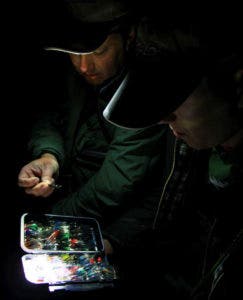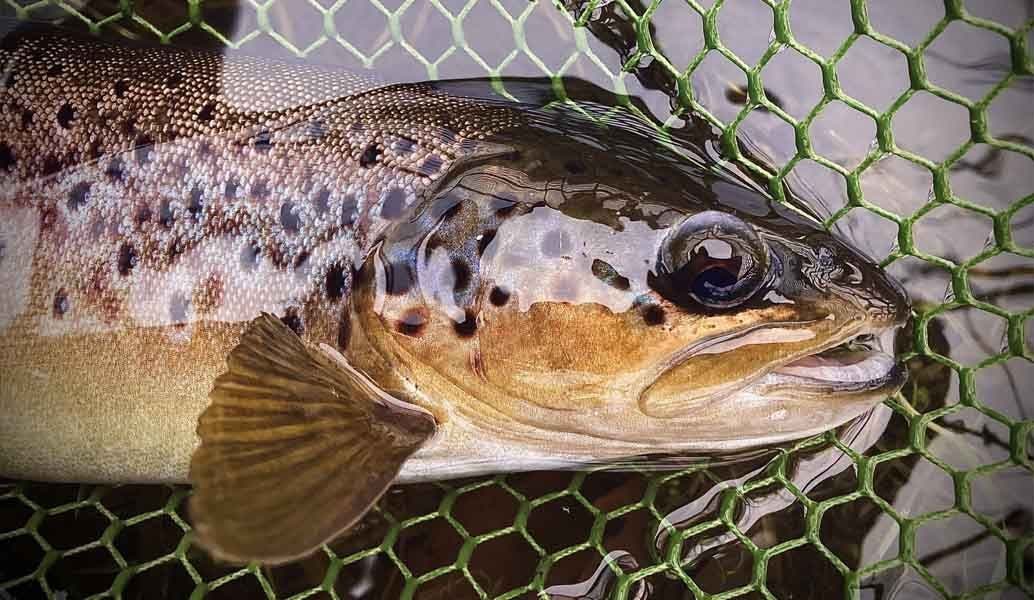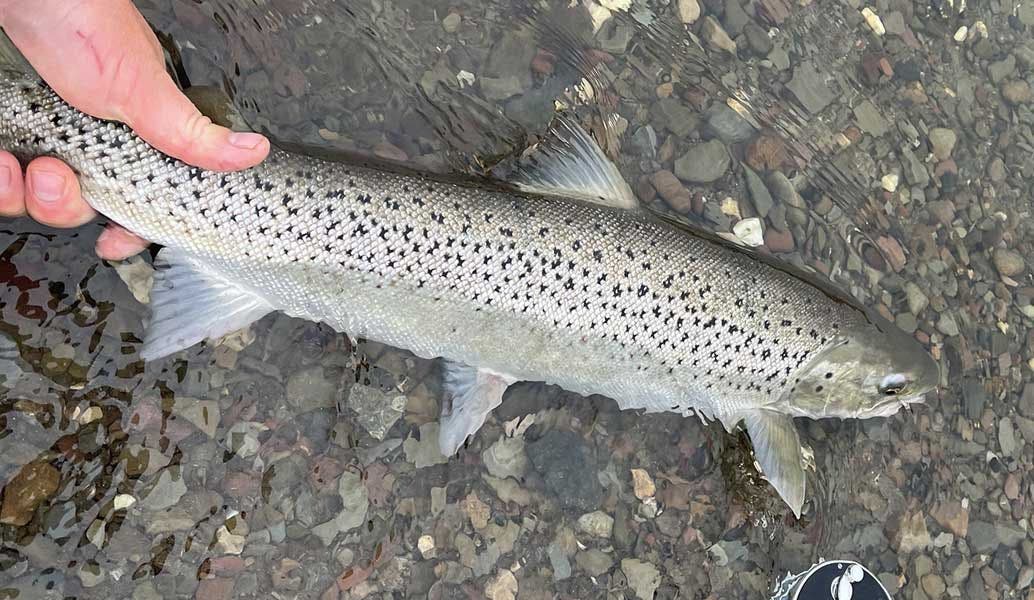When you are born and raised within a ten-minute drive of the River Teifi and fifteen minutes to the River Towy it would be foolish not to pursue sea trout, or sewin as they are better known in this part of the country.
These rivers became my laboratories and countless hours and days were spent pursuing and gaining an understanding of these silver ghosts. What at first was a curiosity soon became an obsession.
That obsession still burns strongly to this day. There is still much to learn and I am eager to undertake the learning process, but certainly some pitfalls and experiences have been gleaned over the years that can make the introduction to a newcomer an easier process.
There is something mystical about sea trout. Sitting on the riverbank in the gloaming, watching house lights disappear as sensible souls make their way to bed. One set of animals settle down for the night as the nocturnal ones begin to make their presence known. It is a magical and relaxing time to be out, a time when you truly feel the weight lift from your shoulders.
As your heart rate settles to a resting pace, it soon receives a spike when a silver tourist leaps clear of the water, making its presence known and breaking the solitude. This becomes the drug and the anticipation is palpable.
Steffan's Top Tips for Sea Trout Fishing
To the newcomer it would seem logical to jump straight in and start flailing around wildly at the first sign of seeing, or hearing, a fish. However, this, along with many other errors, are the pitfalls you should avoid. Let’s address a few that will hold you in good stead when venturing into the darkness and head fly fishing for sea trout.
Do not move into the slow, deep water until it is properly dark
Unless the river is carrying some colour, or extra height, you should concentrate on the faster runs or heads of the pools at dusk. Sea trout are not that wary at night, but can be incredibly wary in the daytime or when significant light levels remain.They will start to move from pool to pool at dusk and will also move into the faster water at the head of the pools etc. so target this type of water before darkness fully descends, rather than the slower holding water where the fish may be easily spooked. Only venture into such water when it is completely dark and do not get tempted because you are seeing fish jump in these areas – they will still be there in half an hour.
Time to start? If the water is low and clear i.e. perfect summer sea trout conditions, then err on the side of caution and do not enter the pool too early. But how early is too early? As a rule, look to enter the pool around an hour after sunset.
Another good indication is colour. When the colour has drawn from the bankside foliage, trees and fields then it’s time to start wetting a line, albeit perhaps in the faster water first if it still seems relatively light. If, however, the river is carrying some colour then the fish will be less easily spooked and since night fishing is rarely productive in such conditions you can target fish before darkness falls.
Do not fish with a light leader
Sea trout are not leader shy at night, so don’t risk fishing a light leader. Use at least a 12lb leader (0.30mm+), with 15lb (0.35mm or so) preferable. Fluorocarbon is not needed, so stick with cheap and cheerful but very reliable Maxima ultragreen or similar.A stronger, thicker leader will also assist with fly turnover, becomes easier to unpick if you get a knot and also you will lose less sea trout flies in the trees as your leader is less likely to snap.
Strike!
These are not salmon, so do not wait for the line to draw away. If you get any indication of a take, strike without hesitation. A sea trout can take and expel a fly within a blink of an eye and one of the hardest parts of hooking a sea trout is striking fast enough in the first place – especially when they rip the line from your hand and you cannot believe they have not hooked themselves.
Make life easy for yourself
I have guided anglers onto sea trout since I was fifteen years old. One of the main issues I see when anglers turn up is badly matched equipment – specifically lines to rods.Whenever possible, use a short-headed fly line that will load quickly under short distances. These will help turn over larger flies and also cut down the need for false casting. Lines such as the Airflo 40+ are ideal, or look to overload your rod rating by at least one line weight.
You are rarely going to be fishing longer than the belly of your line, so utilising a slightly heavier line for your rod helps casting at night – especially when you cannot monitor your loops and especially when you are using heavy flies that can hinge on lighter lines.
As for the fly rod, do not fish a fast/tip action; this is a recipe for disaster! Tight loops are the last thing you want at night when fly fishing for sea trout, as tangles will follow. Choose a slightly softer action (middle to tip), which will also help keep a good hook hold in fresh fish – these have softer mouths where a stiff rod will rip the hook hold.
Keep artificial light to a minimum
 The fish are not particularly ‘shy’ of artificial light and will not go scurrying back to sea if they sense such things – even though old literature may have you believe this. Prolonged exposure will make them wary though, so it is best to avoid it.
The fish are not particularly ‘shy’ of artificial light and will not go scurrying back to sea if they sense such things – even though old literature may have you believe this. Prolonged exposure will make them wary though, so it is best to avoid it.
However, the main reason to keep it to a minimum is to maintain your night vision, which is soon lost once you have utilised your head torch. A red filter can help with this, but keeping any light to a minimum is the best cure.
Also, when changing flies, sorting out the inevitable tangle etc. always turn your back to the water before turning your torch on. This is also being respectful to your fellow anglers and is definitely night-time fishing etiquette.
Don't over complicate your fly selection
I would much rather see someone fish for sea trout at night with every fly being black and silver but then in various length, weights and profiles (silhouettes) than a myriad of different colours in the same length and style.I often hear people saying that they like slim flies for sea trout. Yes, you need slim flies, but you also need fat flies! Try flies with palmered bodies, thick head hackles etc. along with the slim flies. Both are needed in your armoury to present different silhouettes to the fish.
As a simple rule, fish with flies up to one inch long before dark then an inch and above after dark. That should hold you in good stead.

The tug is the drug. Such a true statement in angling in general. However, this, I believe, is exacerbated at night and with sea trout. Your senses are heightened as your body adapts to the darkness. You are like a coiled spring, anticipating that strike.
When the strike does come it is like a jolt of electricity through the body, unlike any other strike because of the added element of darkness. The next shot of adrenaline is a silver torpedo cartwheeling around the pool – at times being airborne more often than not.
 These are just a few tips on fly fishing for sea trout to get you underway.
These are just a few tips on fly fishing for sea trout to get you underway.
However, for a comprehensive understanding, along with lots more tips, fly patterns and more please do take a look at Steffan’s book ‘Sea Trout Tips, tricks & Tribulations’.
[vc_button title="Buy Steffan's Sea Trout Book »" target="_self" color="default" href="https://www.sportfish.co.uk/sea-trout-tips-tricks-tribulations-book.html"]
Combine all these elements and I truly believe there is no experience, or fish, like them that we can pursue in the UK and this makes them so very special. It is easy to appreciate why they soon become an obsession and are regarded by many as the ultimate UK species to target on the fly.
Do you want to try your hand at night-time fly fishing for sea trout? Are you intrigued by this slightly surreal experience and not sure what makes it so special? Steffan Jones explains a few dos and don’ts, along with why this may well be ultimate fly fishing experience for UK anglers…
When you are born and raised within a ten-minute drive of the River Teifi and fifteen minutes to the River Towy it would be foolish not to pursue sea trout, or sewin as they are better known in this part of the country. These rivers became my laboratories and countless hours and days were spent pursuing and gaining an understanding of these silver ghosts. What at first was a curiosity soon became an obsession.
That obsession still burns strongly to this day. There is still much to learn and I am eager to undertake the learning process, but certainly some pitfalls and experiences have been gleaned over the years that can make the introduction to a newcomer an easier process. There is something mystical about sea trout. Sitting on the riverbank in the gloaming, watching house lights disappear as sensible souls make their way to bed. One set of animals settle down for the night as the nocturnal ones begin to make their presence known. It is a magical and relaxing time to be out, a time when you truly feel the weight lift from your shoulders.
As your heart rate settles to a resting pace, it soon receives a spike when a silver tourist leaps clear of the water, making its presence known and breaking the solitude. This becomes the drug and the anticipation is palpable.
Steffan's Top Tips for Sea Trout Fishing
To the newcomer it would seem logical to jump straight in and start flailing around wildly at the first sign of seeing, or hearing, a fish. However, this, along with many other errors, are the pitfalls you should avoid. Let’s address a few that will hold you in good stead when venturing into the darkness and head fly fishing for sea trout.


Don't move into slow, deep water until it's properly dark
Unless the river is carrying some colour, or extra height, you should concentrate on the faster runs or heads of the pools at dusk. Sea trout are not that wary at night, but can be incredibly wary in the daytime or when significant light levels remain.
They will start to move from pool to pool at dusk and will also move into the faster water at the head of the pools etc. so target this type of water before darkness fully descends, rather than the slower holding water where the fish may be easily spooked. Only venture into such water when it is completely dark and do not get tempted because you are seeing fish jump in these areas – they will still be there in half an hour.
Time to start? If the water is low and clear i.e. perfect summer sea trout conditions, then err on the side of caution and do not enter the pool too early. But how early is too early? As a rule, look to enter the pool around an hour after sunset.
Another good indication is colour. When the colour has drawn from the bankside foliage, trees and fields then it’s time to start wetting a line, albeit perhaps in the faster water first if it still seems relatively light. If, however, the river is carrying some colour then the fish will be less easily spooked and since night fishing is rarely productive in such conditions you can target fish before darkness falls.
Do not fish with a light leader
Sea trout are not leader shy at night, so don’t risk fishing a light leader. Use at least a 12lb leader (0.30mm+), with 15lb (0.35mm or so) preferable. Fluorocarbon is not needed, so stick with cheap and cheerful but very reliable Maxima ultragreen or similar.
A stronger, thicker leader will also assist with fly turnover, becomes easier to unpick if you get a knot and also you will lose less sea trout flies in the trees as your leader is less likely to snap.
Strike!
These are not salmon, so do not wait for the line to draw away. If you get any indication of a take, strike without hesitation. A sea trout can take and expel a fly within a blink of an eye and one of the hardest parts of hooking a sea trout is striking fast enough in the first place – especially when they rip the line from your hand and you cannot believe they have not hooked themselves.


Make life easy for yourself
I have guided anglers onto sea trout since I was fifteen years old. One of the main issues I see when anglers turn up is badly matched equipment – specifically lines to rods.
Whenever possible, use a short-headed fly line that will load quickly under short distances. These will help turn over larger flies and also cut down the need for false casting. Lines such as the Airflo 40+ are ideal, or look to overload your rod rating by at least one line weight.
You are rarely going to be fishing longer than the belly of your line, so utilising a slightly heavier line for your rod helps casting at night – especially when you cannot monitor your loops and especially when you are using heavy flies that can hinge on lighter lines.
As for the fly rod, do not fish a fast/tip action; this is a recipe for disaster! Tight loops are the last thing you want at night when fly fishing for sea trout, as tangles will follow. Choose a slightly softer action (middle to tip), which will also help keep a good hook hold in fresh fish – these have softer mouths where a stiff rod will rip the hook hold.
Keep artificial light to a minimum
 The fish are not particularly ‘shy’ of artificial light and will not go scurrying back to sea if they sense such things – even though old literature may have you believe this. Prolonged exposure will make them wary though, so it is best to avoid it.
The fish are not particularly ‘shy’ of artificial light and will not go scurrying back to sea if they sense such things – even though old literature may have you believe this. Prolonged exposure will make them wary though, so it is best to avoid it.
However, the main reason to keep it to a minimum is to maintain your night vision, which is soon lost once you have utilised your head torch. A red filter can help with this, but keeping any light to a minimum is the best cure.
Also, when changing flies, sorting out the inevitable tangle etc. always turn your back to the water before turning your torch on. This is also being respectful to your fellow anglers and is definitely night-time fishing etiquette.
Don't over complicate your fly selection
I would much rather see someone fish for sea trout at night with every fly being black and silver but then in various length, weights and profiles (silhouettes) than a myriad of different colours in the same length and style.
I often hear people saying that they like slim flies for sea trout. Yes, you need slim flies, but you also need fat flies! Try flies with palmered bodies, thick head hackles etc. along with the slim flies. Both are needed in your armoury to present different silhouettes to the fish.
As a simple rule, fish with flies up to one inch long before dark then an inch and above after dark. That should hold you in good stead.


The tug is the drug. Such a true statement in angling in general. However, this, I believe, is exacerbated at night and with sea trout. Your senses are heightened as your body adapts to the darkness. You are like a coiled spring, anticipating that strike.
When the strike does come it is like a jolt of electricity through the body, unlike any other strike because of the added element of darkness. The next shot of adrenaline is a silver torpedo cartwheeling around the pool – at times being airborne more often than not.
Now Get The Guide Book!
These are just a few tips on fly fishing for sea trout to get you underway.
However, for a comprehensive understanding, along with lots more tips, fly patterns and more please do take a look at Steffan’s book ‘Sea Trout Tips, tricks & Tribulations’.
A masterpiece that covers all aspects of sea trout fishing from daytime to night-time fishing, through to weather considerations and more. Contributions from Moc Morgan, Martin Joergensen and others from around the world who have discussed their favourite patterns.
Combine all these elements and I truly believe there is no experience, or fish, like them that we can pursue in the UK and this makes them so very special. It is easy to appreciate why they soon become an obsession and are regarded by many as the ultimate UK species to target on the fly.





